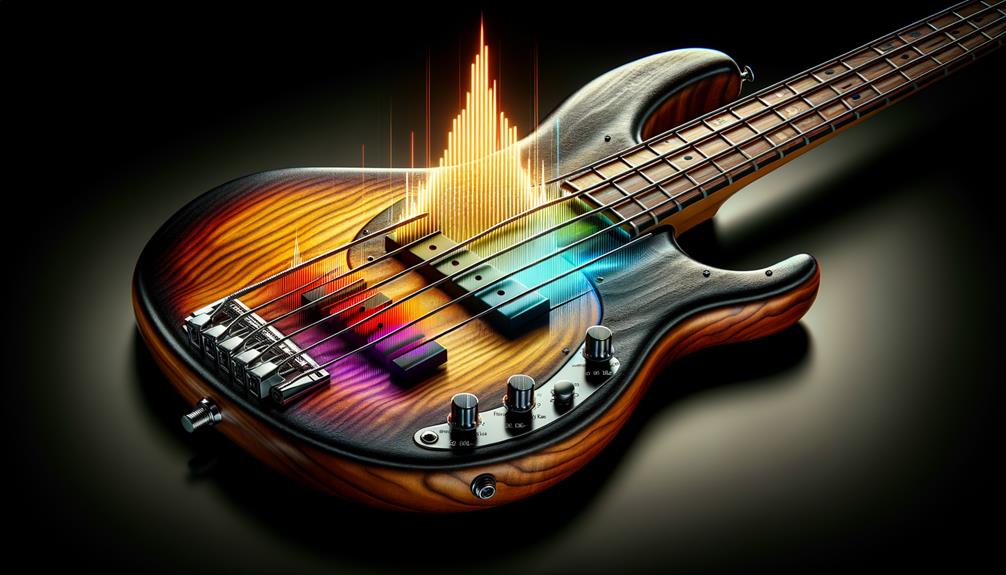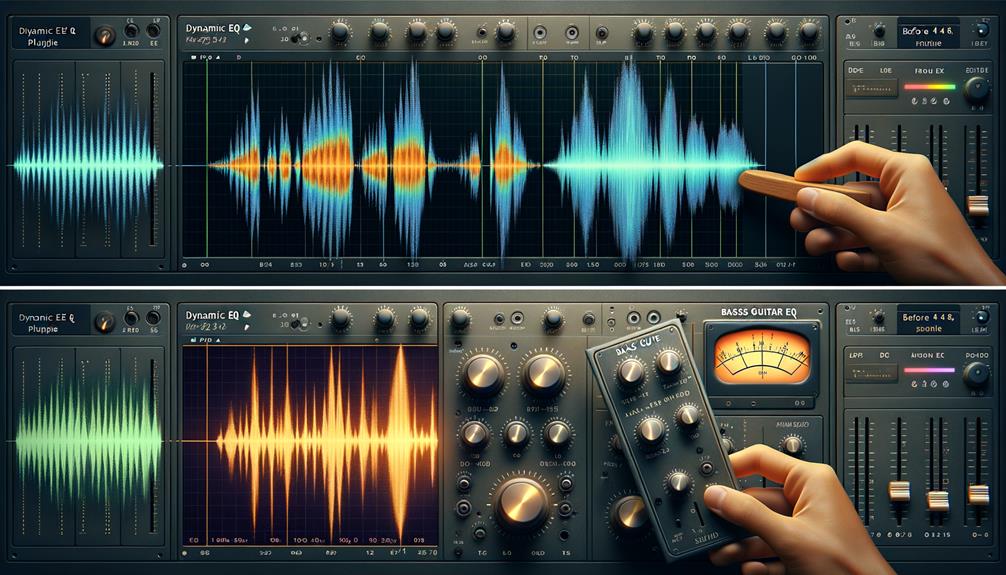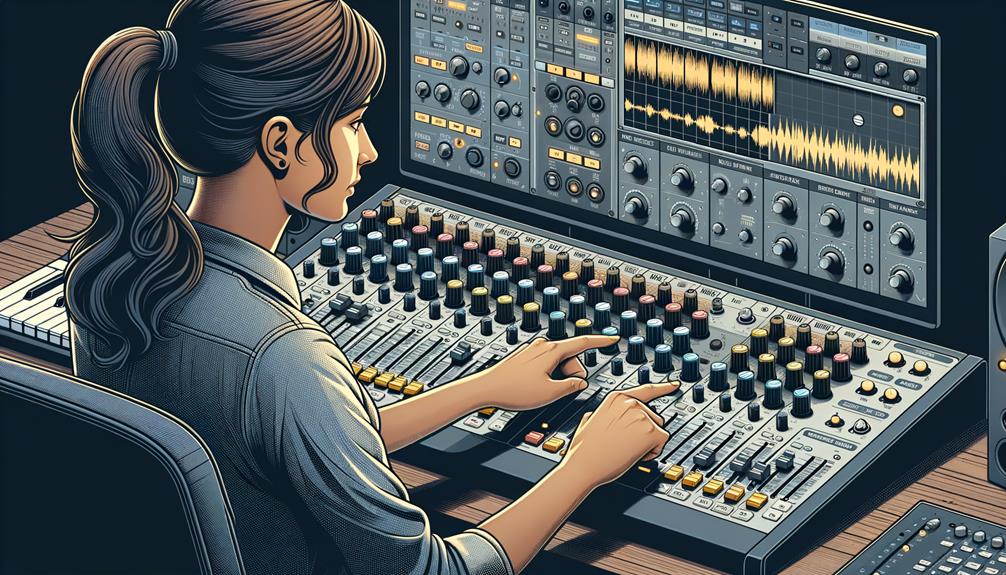No products in the cart.
You’re in the studio, trying to mix a bass guitar that just doesn’t seem to sit right in the track. It’s like trying to fit a square peg into a round hole – frustrating and seemingly impossible.
But fear not, because with the right EQ techniques, you can sculpt that unruly bass into a smooth, powerful foundation for your mix.
Understanding how to carve out space in the mix, enhance the natural character of the instrument, and balance its relationship with the rest of the track is crucial.
So, let’s dive into the world of bass guitar EQ and unlock the secrets to a polished and impactful low end.
Contents
hide
Key Takeaways
- Boosting the 80-200 Hz range adds depth and body to the bass guitar.
- Cutting the 200-300 Hz range reduces muddiness and ensures a clean low end.
- Boosting the 500-1000 Hz range adds punchiness and low-mid grind to the bass guitar.
- Using dynamic EQ can help control problem frequencies and maintain a natural bass guitar recording.
Understanding Bass Guitar Frequency Ranges

Understanding the bass guitar frequency ranges is essential for effectively sculpting and shaping its sound in a mix, enabling you to achieve a well-rounded and clear bass guitar tone.
The fundamental frequencies of the bass guitar typically range from 80 to 200 Hz, which provide depth and body to the sound. Boosting these frequencies can enhance the low-end presence, while cutting in this range can help reduce muddiness.
Moving up the frequency spectrum, the 200 to 300 Hz range is crucial for reducing muddiness, ensuring a clean and defined low end.
The 500 to 1000 Hz range adds punchiness to the bass guitar, contributing to its impact in the mix.
Finally, the 2.5 to 5 kHz range is responsible for providing attack and bite to the sound, allowing the bass to cut through the mix.
Understanding and manipulating these frequency ranges through EQ adjustments is pivotal in shaping the overall presence and impact of the bass guitar, ensuring that it stands out while also blending seamlessly within the mix.
Techniques for Balancing Bass EQ
Balancing the bass EQ involves employing specific techniques to manipulate the frequencies effectively, building upon the understanding of bass guitar frequency ranges discussed earlier. To achieve a well-balanced mix, it’s essential to make room for both the kick drum and bass track. You can achieve this by using a combination of high pass filter (HPF) and low pass filter (LPF) to control the frequency ranges. The HPF can be set to roll off low-end frequencies below 80 Hz, preventing sub-bass buildup, while the LPF can remove high-end frequencies above 5 kHz, creating space for midrange-dominant mix elements. Additionally, when EQing the bass guitar, consider boosting the 80-200 Hz range for depth and body, cutting 200-300 Hz to clear muddiness, and boosting 500-1000 Hz for punchiness and low-mid grind.
| Technique | Description |
|---|---|
| High Pass Filter (HPF) | Roll off low-end frequencies below 80 Hz to prevent sub-bass buildup and achieve a cleaner mix. |
| Low Pass Filter (LPF) | Remove high-end frequencies above 5 kHz to create space for midrange-dominant mix elements. |
Moreover, balancing the kick drum and bass guitar involves choosing one to lead the bottom end and EQing them opposite each other to give each its own space in the low end of the mix. Understanding these techniques and applying them effectively will result in a well-defined and balanced low end in your mix.
Using Dynamic EQ for Problem Frequencies


To address problematic frequencies in the bass guitar, dynamic EQ offers targeted and automatic adjustments in real-time, effectively controlling resonant peaks and harsh frequencies. Dynamic EQ adapts to the audio signal, reducing the need for constant manual adjustments. This technique is especially effective for taming specific frequency issues in the bass guitar, allowing for a more balanced and controlled sound.
By using dynamic EQ, you can maintain a natural and unobtrusive bass guitar recording while addressing problematic frequencies.
- Dynamic EQ allows for targeted and automatic adjustments to problem frequencies in real-time.
- It’s especially effective for controlling resonant peaks and harsh frequencies in the bass guitar.
- This technique can help maintain a natural, unobtrusive sound while addressing specific frequency issues.
Dynamic EQ is a powerful tool for managing the frequency spectrum of the bass guitar. It can effectively cut problem frequencies, allowing the kick and bass to sit together in the mix without conflicting for the amount of low end. This innovative approach to bass EQ moves beyond static adjustments, offering a dynamic solution to the complex frequency content of the instrument.
Enhancing Bass Presence With High-Mid Boost
Boosting the high-mids around 1 kHz in the bass guitar enhances its presence and articulation in the mix. This boost adds definition and helps the bass guitar cut through the mix without overshadowing other instruments. By carefully adjusting the high-mid frequencies, you can bring out the attack and plucking sound of the bass, thus enhancing its impact and ensuring it stands out in the mix.
When EQing bass, increasing the high-mid frequencies within the 1-3 kHz range can significantly improve the harmonic content and overall clarity of the bass guitar sound. To execute this high-mid boost effectively, use studio headphones or monitors with a flat frequency response, allowing you to accurately perceive the changes in the upper mid-range.
It’s crucial to maintain a balanced mix, and enhancing the high-mid frequencies contributes to achieving this balance while elevating the bass guitar’s presence. When implementing this EQ technique, be mindful of not overdoing the boost, as excessive high-mid frequencies can lead to a harsh or piercing sound. Instead, aim for a moderate boost that accentuates the bass guitar’s articulation and prominence in the mix.
Tips for Subtle and Effective Bass EQ


Enhancing the bass guitar’s presence can be achieved through subtle and effective EQ techniques that build upon the harmonic content and clarity introduced by the high-mid boost in the previous subtopic.
To further refine the bass guitar’s sound and ensure its seamless integration into the mix, consider the following tips:
- Utilize a High Pass Filter (HPF) to clean up the bottom end of the mix, preventing muddiness and allowing the bass to shine through without overpowering other elements.
- Implement a Low Pass Filter (LPF) to create space for midrange-dominant mix elements, avoiding competition and achieving a more balanced overall sound.
- Balance the kick drum and bass guitar in the mix by leveling and EQing them opposite to each other, allowing each to occupy its own sonic space while complementing one another.
Frequently Asked Questions
How Do You Set up an EQ for a Bass Guitar?
To set up an EQ for your bass guitar, focus on tone shaping by boosting low end for depth, cutting midrange for clarity, and rolling off high frequencies. Utilize notch filtering, graphic equalizer, parametric EQ, bass tone, and EQ pedal with your bass amp.
What Is a Good EQ for Bass?
For a good bass tone, use EQ techniques to enhance low frequencies, shape the tone, and increase bass presence. Adjust EQ settings to clear subwoofer frequencies, improve bass clarity, and add punch to the sound.
What FrEQuency Should I EQ My Bass?
You should EQ your bass at different frequency ranges to shape its tone and balance. Techniques like boosting the 80-200 Hz range for depth, cutting 200-300 Hz to reduce muddiness, and boosting 500-1000 Hz for punchiness are recommended.
How Do I Boost My Bass With Eq?
To boost your bass with EQ, utilize an EQ pedal for subtle adjustments within the key frequency range. Enhance low end punch by boosting frequencies in the 80-200 Hz range while shaping bass tone and enhancing presence.
Conclusion
Now that you understand the key frequency ranges and techniques for balancing and shaping the bass guitar sound, you can effectively EQ your bass to create a clean mix with depth and presence.
Remember to experiment and practice with different EQ plugins to find the right tools for your sound.
By using dynamic EQ to address problem frequencies and boosting high-mids for presence, you can achieve subtle and effective bass EQ.
Keep refining your skills and mastering bass guitar EQ techniques.




